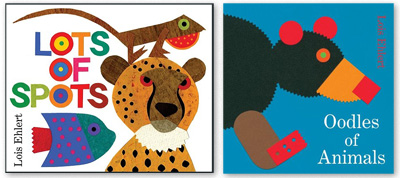Teaching STEAM with Lois Ehlert: Preschool isn't too early to introduce STEM + art
 Looking over 20 years’ worth of storytime plans that I have created for my toddler and preschool programs, I notice that one author’s name appears quite regularly: Lois Ehlert. Her titles are instantly recognizable with their vividly hued collages and repurposed objects, used in artistic ways. When I pulled a batch of her books off my local library’s shelves to reminisce, I realized how relevant the titles are, particularly in a STEAM (STEM+art) setting.
Looking over 20 years’ worth of storytime plans that I have created for my toddler and preschool programs, I notice that one author’s name appears quite regularly: Lois Ehlert. Her titles are instantly recognizable with their vividly hued collages and repurposed objects, used in artistic ways. When I pulled a batch of her books off my local library’s shelves to reminisce, I realized how relevant the titles are, particularly in a STEAM (STEM+art) setting.
STEAM programs incorporate science, technology, engineering, art, and math ideas and concepts. Think that’s too technical for toddlers and preschoolers? Think again. An early learning librarian can easily pull together a multi-week STEAM program using many of Ehlert’s titles. Take, for instance, Oodles of Animals (Harcourt, 2008). Dozens of short poems demonstrate the diversity of the animal world. Looking at the title through a STEAM lens sparked the following ideas:
S IS FOR SCIENCE: Ehlert introduces young readers to over 60 different animals, fish, and insects—ranging from a gecko to a cardinal, a porcupine to a walrus.
T IS FOR TECHNOLOGY: Librarians can pair Oodles of Animals with a number of kid-friendly databases to show what the animals look like in “real life.” Or visit the National Zoo in Washington, DC, virtually at nationalzoo.si.edu/default.cfm, to view some of the special animal cams hosted on the page.
E IS FOR ENGINEERING: Let’s talk paper engineering, shall we? Ehlert used nine shapes as the basic structure for her cut-paper collage illustrations—squares, rectangles, triangles, circles, diamonds, half circles, ovals, hearts, and teardrops. Ask young learners to point out specific shapes as they see them.
A IS FOR ART: Hand out scissors and practice making shapes. Then have little hands turn those shapes into unique paper animals. While Oodles of Animals doesn’t use anything other than paper, many other Ehlert titles create art using scraps of wood, screws, nuts, bolts, soda can pop-tops, and other recycled items. Ask participants to bring a bag of “stuff” to the next story session to see what kind of critters can be created!
M IS FOR MATH: Did I mention that there are more than 60 different animals in this title? Students can count them, categorize them, create graphs based on types of animals, etc…. Then there are all of those shapes that are spread throughout the pages just asking for something like a mathematical scavenger hunt. Get multiple copies of the text, and break up into groups: who can find the most hearts? Ovals? Teardrops?
Of course, behind the STEAM is a beautifully written text filled with playful poems that will make any child smile. Talk about wonderful words and vivacious vocabulary! Here is one example:
FLEA AND FLY A fly can flee. A flea can’t fly. But a flea can flee And a fly can fly.
Not only is Ehlert introducing young readers and listeners to homophones (flea, flee) and homonyms (fly, fly,) but also to vocabulary that can be introduced via direct questioning: “What do you think the word ‘flee’ means?” In “Starfish and Sea Horses,” Ehlert introduces the terms “gallop” and “trot.” Next time you have a few preschoolers in front of you, ask them to act out for you the difference between a gallop and a trot. Then try not to smile. It is impossible, I tell you.
Because all of the poems contain rhymes, they lend themselves to being shared out loud with the rhyming word left off, letting the group try to chime in to supply it. There are so many ideas, all from one title. Pair Oodles of Animals with Lots of Spots (S. & S., 2010) and delve into some more STEAMy fun. What are some of your favorite titles to use with toddlers and preschoolers in a science-based program?
RELATED
The job outlook in 2030: Librarians will be in demand
The job outlook in 2030: Librarians will be in demand
ALREADY A SUBSCRIBER? LOG IN
We are currently offering this content for free. Sign up now to activate your personal profile, where you can save articles for future viewing





Add Comment :-
Comment Policy:
Comment should not be empty !!!
chelsea
Great ideas!Posted : Aug 07, 2015 05:53
Jillian Lazaridis
I enjoyed reading the article and have incorporated the main points into my library lessons. Is there any chance of sharing one or two of the lessons you mentioned. Though we are a Pre-K3 through the 8th grade school, 50% of our population is in PreK3 through Kindergarten. Thank you for sharing your great ideas JillianPosted : Apr 07, 2015 09:27
Sondra
These are great ideas! I can't wait to check out these books. Some of my favorite science-y authors for little ones are Andrea Beaty, Nancy Elizabeth Wallace, Jan Wahl, and Anne Rockwell.Posted : Dec 04, 2014 11:49